| |
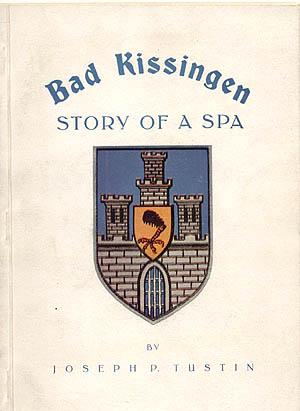
The booklet that
started the search; who was Joseph P. Tustin and how did he come to
write this popular little history book that so many early veterans
who passed through Bad Kissingen, retain to this day in their
footlockers?
--Stefanowicz
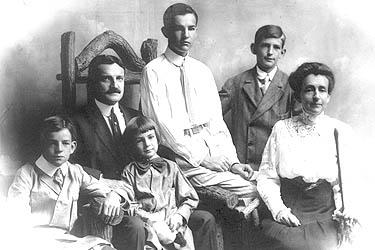
The Tustin family
probably in 1907 - 1908. From left: James Tustin, Edward Bright
Tustin (father), Henry O. Tustin, Edward Tustin, Joseph P. Tustin
and Helen Tustin (mother).
--MSG (Ret) Frederick G. Scott USAF
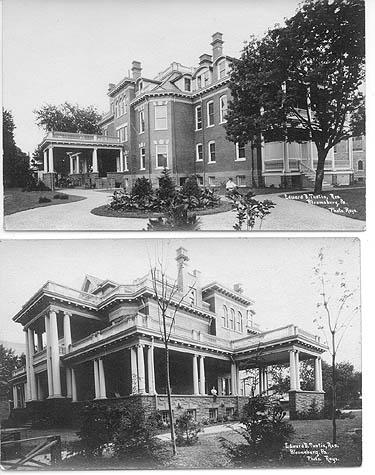
Two views of the
Tustin family home in Bloomsburg, Pennsylvania
--MSG (Ret) Frederick G. Scott USAF
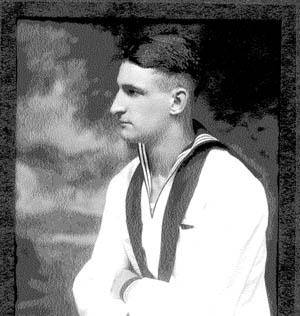
Joseph P. Tustin with
the US Navy during service in WW1.
--MSG (Ret) Frederick G. Scott USAF
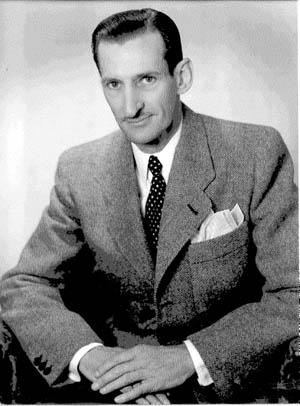
CPT Joseph P. Tustin
in Bad Kissingen, 1947.
--MSG (Ret) Frederick G. Scott USAF

Any American fears
concerning the German civil population quickly ended. Here Army Air
Force men and a German woman share drinks at a cafe. Fraternization
was frowned upon but the end of the war and an easy occupation led
to looking the other way.
--John Allred
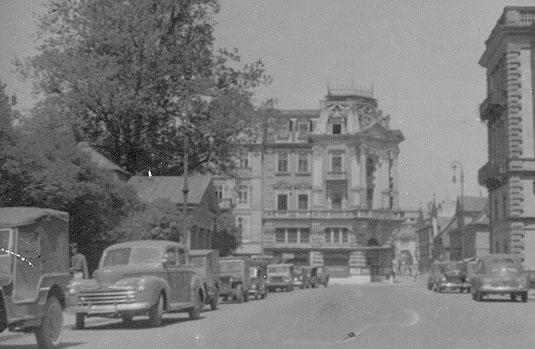
Bad Kissingen as John
Allred found it during the same time that CPT Tustin was working on
the history project. American cars and GIs, the Germans were on a
pass system if they were allowed at all into the American zone.
--John Allred
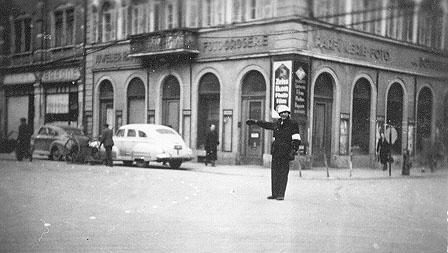
Another John Allred
image of BK in 1946 - 1947.
--John Allred
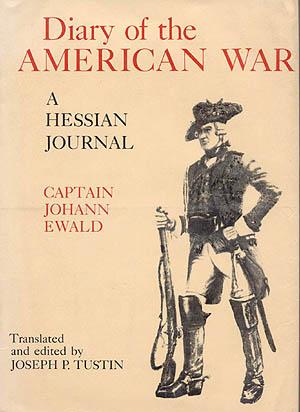
Tustin's major
contribution to American history, the widely read Diary of the
American War, it began when a German came forward to sell or trade
three of the four original written volumes.
--Stefanowicz

The Hotel Victoria, in
American hands as a HQ space.
--Tustin Booklet
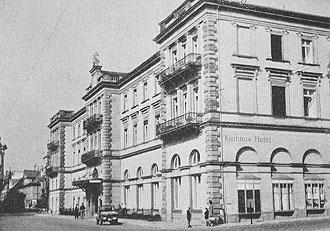
The Kur Haus Hotel in
American hands, this is where Lt ( Col Ret ) Hanson and his wife
spent their first few days in Bad Kissingen. BK was one of the
regional personnel assignment hub cities.
--Tustin Booklet |
|
|
The Historian and the Hotels
Captain Joseph P. Tustin: US Army Air Corps
Bad Kissingen certainly had appeal in the post war period to the US
Army because so much of the town and its infrastructure remained
intact. Not surprisingly, the XII Tactical Air Command and earlier,
the 9th Army Air Force Headquarters established themselves in the
hotels if only for a comparatively short period, while waiting for
redeployment orders. It must have been an interesting period as the
downtown area was fenced off to create the American sector and the
Germans were removed except for day workers on a pass system. US MPs
patrolled the streets and American military sedans cruised the
boulevards.
Kur Haus Strasse, the main promenade through town had been re -
named as Adolf Hitler Strasse during the Third Reich, one of the
very few overt concessions the town made to the regime. The
Americans promptly changed the name to Roosevelt Street and were
everywhere in the small town, a rapid transition from combat
soldiers to tourists. For most, it probably was a pleasant diversion
while waiting to go home. One trooper, however, Captain Joseph P.
Tustin, with his notebook and typewriter case in hand, had a project
from his superiors and set diligently to work. His task was to write
and publish a local English language guide book of the Bad Kissingen
area for the local command.
Joseph P. Tustin's early life is something of a mystery. He was from
a large and initially affluent family living in Bloomsburg
Pennsylvania. Apparently his father, Edward Bright Tustin, was
involved in banking and finance with the official title of “cashier"
but in the language of the day, this was probably a lead accounting
position. He had also been the Treasurer of the Greene Consolidated
Copper Company but he met with serious trouble when financial notes
assigned to friends defaulted and Edward Bright Tustin was held
financially liable. Robert Dunkelberger, Archivist of the Tustin
papers at Bloomsburg University:
“As for Joseph P. Tustin, it appears his entire education in
elementary and middle school was here at the Bloomsburg State Normal
School's model school, which accepted students from the town and
helped to train teachers. He completed his basic education in the
Spring of 1913, and in the fall when he was 16 he entered the
regular normal school program. He and his brother James were here
for the fall term and began the winter term on December 1, but they
both left school on December 19, 1913, and did not return to the
normal school. So Tustin did get some education here, but did not
graduate. I believe that due to his financial difficulties Tustin's
father, Edward Bright Tustin, left Bloomsburg around this time for
Ocean Grove, NJ. Up until 1913 the home address for the Tustin
children (all four brothers went to the model school) was
Bloomsburg, but the New Jersey address is given for the fall of
1913. "
“Joseph Tustin served in the Navy and two of his brothers served in
the Army during World War I. For at least part of that time, Joseph
was stationed in Philadelphia before going over to France. Edward
Bright Tustin, the father, died on May 14, 1941. It appears Joseph
P. Tustin was named for his grandfather, the Rev. Joseph P. Tustin.
At the time of his father's death Joseph Tustin was living in
Sewaren, NJ."
Details of Tustin's life in the between war period are fragmentary.
He followed his father to Wall Street initially, married then
divorced and during the Depression, became involved with the Federal
Government Civilian Conservation Corps program. He held a leadership
position and apparently, this led to Officer Candidate School or one
of the other related commissioning programs and his service in the
Army Air Corps as an Intelligence officer. An initial screening of
records related to commissioned historians of the Air Force produced
no facts but this is not surprising. Internal staff history projects
were written and filed and have not necessarily been fully
cataloged. With the publishing of the Bad Kissingen booklet,
Tustin's public life begins.
Captain Tustin finished the guide book in late 1946 and there were
two print runs by the local German press. With a full color cover
featuring the coat of arms of the city of Bad Kissingen, illustrated
with both photographs and copies of historic prints from local
German sources and running sixty pages with a regional map, as an
overview of the local history of the area, it stands up very well to
this day. It was a popular souvenir with US troops and many we have
contacted from that period remarked ... “I have that Tustin book,
would you like me to send you a photocopy?".
Tustin was fluent in German and finding the source material must
have been a fairy easy process. The German tourist industry reported
that through the pre - war years, 13 % of the tourists coming to Bad
Kissingen were English speakers. The hotel and tourism managers
still in the city after the war appear to have been very cooperative
with Tustin's research and probably, much of the early history of
the town he wrote came directly from existing brochures the Germans
brought to his office. Tustin noted the help he received from many
local Germans, from hotel managers to out of work tourism officials
to typesetters in drafting his history. Relations only improved as
rules were relaxed around the American zone and daily departures of
US forces freed sections of the town from occupation.
The booklet, concentrating on the early history of the town, spends
little time on the “current” state of affairs in Bad Kissingen; a
scant five short paragraphs recall that little fighting occurred in
the area and that much of the town initially had been a German free
zone. His closing paragraphs,
“Now filled to overflowing with American soldiery and their
dependents, displaced persons and perplexed inhabitants, Bad
Kissingen has lost the gilded mirror of pre - war fashion."
“Yet the dignity of her old - world elegance still greets the guests
from the new world - who did not come just to take the 'cure' . "
Captain Tustin's next task was to draft a similar city history for
the Army Air Forces located in the town of Giebelstadt, near
Wurzburg. The 55th Fighter Group, part of the XII Tac Air Command,
had occupied the former German airfield and it appeared they
would be staying for some time.
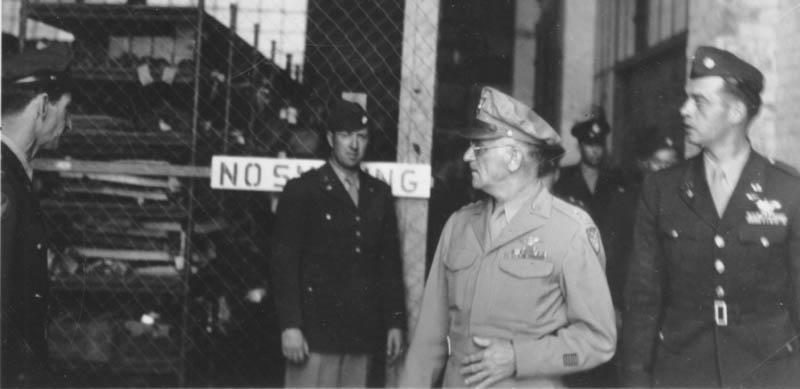
This image is from the
Joseph P. Tustin papers at Bloomsburg University. Probably taken
at Giebelstadt Air Field, CPT Tustin is on the far left of the image,
other parties are unknown.
--Robert Dunkelburger
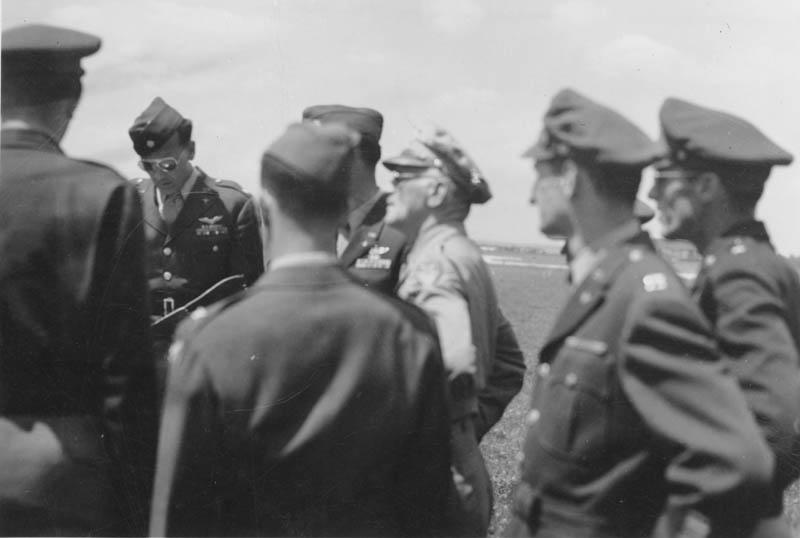
Same day, Tustin
second from right.
--Robert Dunkelburger
In the late 1940s and into the middle 1950s, Major Tustin remained
in Germany with the Air Force as the European Command Historian.
Although we are searching for a list of his works from that period,
it seems that much of his time was devoted not to publication but
rather working on internal documents and unit histories for the
command. Quite by luck, he came across three of the original four
volumes of a personal diary maintained by a Hessian officer, Captain
Johann Ewald, in service with the English Army during the American
Revolutionary War. An interesting sidelight, Ewald's long career
never brought him to the Bad Kissingen area but he was from Kassel,
located 200 miles to the north.
The translation, annotation and publication of this document became
Tustin's life long passion. After searching across much of western
Europe, in 1959 he finally found a hand drafted copy of the missing
volume of the diary in north Germany. Twenty years later, Tustin's
major popular historical work, Diary of the American War: A Hessian
Journal of CPT Johann Ewald, was published. The book was a “best
seller” and combines a wealth of detail with a readable style.
Johann Ewald was a keen observer of his command, their campaigns and
the American colonies in the war. His recollections, brought to
light entirely through Tustin's work, were a significant
contribution to the understanding of the English - Hessian side of
the campaigns.
Thoroughly researched and annotated, Diary appears both on most
college reading lists for that field of study and book lists for the
average reader interested in the military history of the American
Revolution. While working on this project, there were other
interests. He provided background on the Cold War, the US Air Force
and the Berlin Airlift to the famous novelist, Leon Uris, used in
his 1963 novel Armageddon. Other Tustin works from this period
include The Mysterious Widow, another American Revolutionary War
study and United States Air Force Humanitarian Missions, 1945 -
1962.
In his later years, Joseph P. Tustin, who preferred his writings
rather than his personal life to be matters of public record, lived
quietly in south coastal New Jersey with his brother. He never
remarried. Mr. Tustin died on 4 December, 1986 and his professional
papers, mostly limited to the vast notes and drafts associated with
Diary, are kept at the University Archives, Bloomsburg University,
Pennsylvania.
Accompanied Travel: Bad Kissingen, US Army Regional Personnel Hub
As the Cold War began and US deterrent forces began to flow into
Germany, accommodations were in short supply. 7th Army developed a
regional personnel holding system built on city hubs. Arriving
officers and their families initially reported to their “hub” city
to wait for final orders and quarters to be found at their final
destination. Bad Kissingen was one such hub and at least three local
hotels were in Army possession to accommodate couples and families
eventually assigned to Fulda, Wurzburg and other south - central
German garrison towns.
Colonel (Ret) Ray Hanson recalls his arrival in Germany and brief
stay in Bad Kissingen in 1950.
“Immediately after being commissioned (and married), the Army posted
me to Germany. My new wife and I were able to get concurrent travel,
and sailed east aboard the USN General Patch. This was not as
romantic as you might think. The men were billeted down below decks.
Our wives, and some female officers, were in cabins on upper two
decks. We could meet our wives during the day, but the Troop
Commander forbade even hand holding on deck! The ship disembarked us
at Bremerhaven, on July 21, 1950 We and a few dozen others were sent
to Bad Kissingen (wherever that was!) to await assignments. The
mission, we were warned, was protecting the West from the Soviet
anticipated incursion into Western Europe. "
“First, a train took us to Wurzburg, then a GI bus bounced us over
about 30 kilometers of cobblestones to Bad K. Passing through
Wurzburg, someone pointed out the square where some US fliers,
downed during the war, had reportedly been burned at a stake in
middle of town. I should say used to be the town, because Allied
bombers had revenged their comrades by leveling most of it. (( no
evidence of executions occurring in Wurzburg, this was probably one
of those stories that lived on through the telling regardless of the
facts )) So much for first impressions. Bad Kissingen, however, was
in a different universe. It had either been (like Heidelberg) an
"open city" or very lucky. It was a prototype of a classic spa. The
kind of resort where rich people come to ' take the waters ' (which
are full of mag-sulfate, Epsom Salts to be specific)."
“Most takers of these waters were prestigious folks, strolling
around the park sipping its waters through straws from glass cups.
During the occupation years, the Army requisitioned these and many
other Kur hotels and used them as a holding point for people like
us, pending assignments. Our bus dropped people off at various
hotels, finally stopped at a handsome place, the Kurhaus Hotel where
we and two senior officers with their families were let off. I
suspected something was not right, but did as told. Turned out, the
billeting officer's paperwork listed me as Lieutenant Colonel, not a
mere Lieutenant! The escort officer wasn't about to go to the
trouble of rearranging room assignments at that late hour, and said
just take advantage of it. Nor were we about to object, though we
were disappointed to be separated from our shipmate friends. "
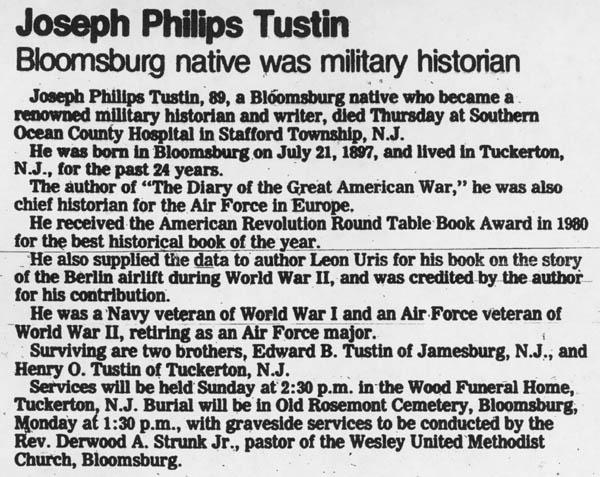
Obituary
--Robert Dunkelburger
“The room we were assigned had undoubtedly been used by royalty in
days gone by (one of the hotel's rooms was marked: Bismark had once
been a guest ). Our bathroom was as big as a US hotel bedroom. Years
later, in the 70s when we were again stationed in Germany, we
thought we would splurge on a weekend get away and go back there for
old times sake. But it was not to be. Even an economy room now cost
several hundred dollars per night! Our first morning it was good to
find that friends billeted in other hotels were coming in to this
hotel dining room, which was apparently the mess hall for all. That
said, our friends were not in good humor. They were itching. Bed bug
bites (which we had escaped) had struck. Those days, conditions
could be like that. For me, however, our mistaken room assignment
showed that an Army snafu is not always a disadvantage."
"On our first evening in Bad K, we met an officer actually stationed
there, what a plum of an assignment he had! He, proud of his town,
took us all around. By dark it was kind of spooky, no streetlights
and hardly a soul to be seen. He introduced us to our first
Schlosskellar."

Rare post card of the
Hotel Villa Elsa - "US Army Transient Billet". On the reverse, this
was the message " Mom & Lee: the hotel we are staying at until we
get quarters in Wurzburg. Love .... Marion, Gail Ann and Ted " .
This was one of many hotels in use by the Army, either as billets or
office space.
--Stefanowicz
“The place, down some steps in a dark basement, was right out of the
movie The Third Man. In a dark corner alone musician was playing the
Third Man theme, on a zither yet! When we ordered, along with our
very first German beer, we asked the waiter if he could bring us
some bread and cheese (we were famished after the long day on trains
and bus). We waited and waited, wondering. When the waiter returned,
he presented a work of art, and we understood why the wait: with a
flourish he put before us a white mouse perfectly sculpted of cream
cheese! It had a length of chive for tail, tiny bits of radish for
ears, and black peppercorns for eyes. It was sitting, mouse-like, on
a delicious slice of black pumpernickel. Needless to say, we
returned the next night for more beer, bread, cheese, and zither.
This mini-vacation honeymoon lasted a too short (and hardly
expected) week. From there I was posted to the Heidelberg-Mannheim
area. An apartment would not be ready for a week or two, so we were
billeted in the Truman Hotel in nearby downtown Mannheim. My wife
and I made the best of it, Mannheim had been heavily bombed and was
still very much in the recovery process. We always remembered how my
first tour and career began, at the finest hotel in Bad Kissingen."
As reconstruction continued in Germany, the hub system was no longer
needed by 1953 - 1954. Arriving military families could report
directly to their gaining installation in almost all cases.
Great thanks to Col (Ret) Ray Hanson, Mr. Robert Dunkelburger of
Bloomsburg University and MSG (Ret) Frederick G. Scott USAF for assisting us with
text and images to tell this chapter of the American history in Bad Kissingen.
|
|